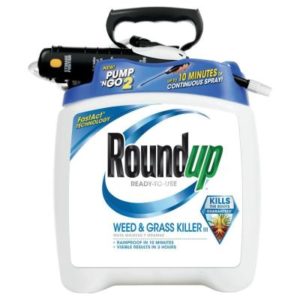 People don't realize the incredibly large amounts of pesticides applied to crops and soil in the US each year. Hundreds of millions of pounds! Which is the reason pesticides are found in our air, rain, water, soil, our foods, and in our bodies.
People don't realize the incredibly large amounts of pesticides applied to crops and soil in the US each year. Hundreds of millions of pounds! Which is the reason pesticides are found in our air, rain, water, soil, our foods, and in our bodies.
One of the pesticides that scientists are getting increasingly concerned with is the weed-killer glyphosate. It is the most used herbicide (weed-killer) in the world! It is found in Roundup, in non-organic crops, and even in genetically modified crops that are glyphosate resistant. Especially used on corn and soybeans, but also in a variety of crops (e.g., wheat, oats, cranberries, grapes, apples, beans).
The following story lays out the great amounts used in some states, especially in the midwest and southern states. Overall, an average of almost 130 pounds of glyphosate were sprayed per square mile in US counties each year.
But some counties had incredibly high amounts, such as Nueces County, Texas which has the highest use of glyphosate: more than 1,100 pounds sprayed per square mile. Iowa and Illinois (corn and soybean crops) accounted for 15% of national usage. The least was in northeastern (e.g., Massachusetts) and southwestern states (e.g., Nevada).
Evidence for health harms are increasing each year, such as an increased risk of cancer (e.g., non-Hodgkin lymphoma), premature births, endocrine disruption, and even disruptions of the gut microbiome (it kills beneficial microbes in the gut). The percentage of people with glyphosate detected in their urine, and the amount (concentration) has been rising over time. It can now be detected in almost all of us.
By the way, the EPA has raised "allowable limits" of glyphosate in foods over the years - when the pesticide industry asked for it. The US limits are much higher than those allowed in Europe - twice the levels! (Once again, in the US the EPA favors industry, not the people it's supposed to be protecting.)
This article is from October 2022, but it highlights the incredibly high amounts of glyphosate applied in the US (see the good interactive map). Excerpts from NBC News: A potentially cancer-causing chemical is sprayed on much of America’s farmland. Here is where it is used the most.
Every day, farms across the country use a potentially cancer-causing chemical that is in the world’s most common weedkillers. And data shows that it’s most used in the Midwest and parts of the South.
Glyphosate, the active ingredient in many herbicides, has been in use for nearly 50 years. The chemical’s health impacts have for years been heavily debated in studies, U.S. and international regulatory filings and in lawsuits filed after the the World Health Organization’s International Agency for Research on Cancer concluded in a 2015 report that the chemical “is probably carcinogenic to humans.”
The Environmental Protection Agency has maintained that there is no risk to human health based on current uses and that there is no evidence glyphosate causes cancer. Bayer, the pharmaceutical company that sells the most widely used glyphosate herbicide, says it stands by the safety of the chemical.
Glyphosate’s main use is in agriculture. Weedkillers containing it are used on nearly half of all planted acres of corn and soybeans in the U.S., though much of those are not grown for human consumption. They’re also used on acres of farmland where wheat, oats, fruits and cotton are grown. Pesticide residue testing from the FDA found glyphosate residues on a wide variety of crops, including oats, soybeans, cranberries, grapes, raisins, oranges, apples, cherries and beans. Data from the U.S. Geological Survey shows several counties across the country with higher than average glyphosate usage.
Being in a county with higher than average glyphosate use does not necessarily lead to increased exposure. A 2020 Department of Health and Human Services report notes that the greatest potential exposure is among farm workers and gardeners that use glyphosate-based herbicides and those who live near farms, manufacturing plants where glyphosate products are produced and hazardous waste disposal sites that contain it.
For the general public, the report notes that exposure to glyphosate typically comes by touching or eating food or water containing residues or inhaling mists or spray while using it. For those only exposed through food, the EPA says that glyphosate residues on food are safe up to certain thresholds.
The EPA’s safety limits for glyphosate exposure from food are twice the levels allowed in the European Union. Its runoff is recognized by the agency as a drinking water contaminant at levels that correspond to approximately 1 gallon of Roundup in an Olympic sized pool, according to an NBC News calculation.
Much of the debate about glyphosate’s health implications revolves around a potential link to non-Hodgkin lymphoma. A 2019 analysis conducted by former EPA science review board members indicated a “compelling link” to the disease. Several peer-reviewed studies have also suggested that herbicides containing glyphosate may disrupt hormones and alter the gut microbiome.
Glyphosate’s use in the U.S. has skyrocketed since 1996, the year Monsanto introduced genetically engineered seeds that could survive being sprayed with higher quantities of herbicides.
Today, almost 90% of corn, cotton and soybean crops are modified to be tolerant to glyphosate and other chemical treatments used by farmers, U.S. Department of Agriculture data shows.
